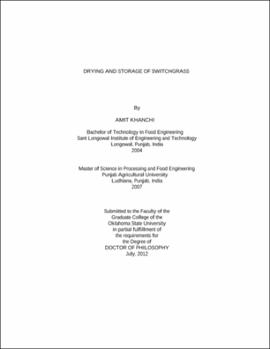| dc.contributor.advisor | Jones, Carol L. | |
| dc.contributor.author | Khanchi, Amit | |
| dc.date.accessioned | 2013-11-26T07:43:15Z | |
| dc.date.available | 2013-11-26T07:43:15Z | |
| dc.date.issued | 2012-07 | |
| dc.identifier.uri | https://hdl.handle.net/11244/6414 | |
| dc.description.abstract | Scope and Method of Study: Switchgrass is recognized as potential bioenergy crops for bioethanol production. Economic analysis, and biomass supply chain and logistics planning require estimation of storage losses as well as drying time needed for safe storage of biomass. The broad research objectives were to develop an empirical model to predict drying rate of switchgrass based on environmental variables, and evaluate the effect of individual weather parameter on the drying rate of switchgrass. The second broad objective includes assessment of qualitative and quantitative losses in round and square switchgrass bales stored under different conditions. | |
| dc.description.abstract | Findings and Conclusions: For the drying study, an environmental chamber was fabricated that can simulate field drying conditions. An empirical drying model based on maturity stage of switchgrass was developed which was dependent on the environmental conditions of solar radiation, vapor pressure deficit and wind speed. During both maturity stages, radiation intensity was positively and strongly correlated with drying rate. Vapor pressure deficit was also positively correlated (r=0.50) with drying rate during the seed development stage of maturity, but the effect was not significant for later stages of maturity. In environmental chamber, the effect of air speed was found to be dependent on radiation intensity. Under high radiation intensity, increase in wind speed decreased the drying rate of switchgrass. However, under low radiation intensity, increase in wind speed increased the drying potential of switchgrass. | |
| dc.description.abstract | In the storage study, outside tarped bales resisted moisture accumulation and thus dry matter losses were equivalent to bales stored inside. Untarped square bales consistently had higher moisture contents than untarped round bales. Highest dry matter loss (38.47%) was observed in uncovered square bales stored outside on gravel. Hemicellulose content was more severely affected than the cellulose content during storage. In 2010, untarped square bales stored on gravel, ground and pallets lost 30%, 24% and 16% of hemicellulose content, respectively. | |
| dc.format | application/pdf | |
| dc.language | en_US | |
| dc.rights | Copyright is held by the author who has granted the Oklahoma State University Library the non-exclusive right to share this material in its institutional repository. Contact Digital Library Services at lib-dls@okstate.edu or 405-744-9161 for the permission policy on the use, reproduction or distribution of this material. | |
| dc.title | Drying and storage of switchgrass | |
| dc.contributor.committeeMember | Huhnke, Raymond | |
| dc.contributor.committeeMember | Weckler, Paul | |
| dc.contributor.committeeMember | Maness, Niels O. | |
| osu.filename | Khanchi_okstate_0664D_12180.pdf | |
| osu.accesstype | Open Access | |
| dc.type.genre | Dissertation | |
| dc.type.material | Text | |
| dc.subject.keywords | cellulose | |
| dc.subject.keywords | compositional changes | |
| dc.subject.keywords | drying | |
| dc.subject.keywords | dry matter loss | |
| dc.subject.keywords | storage | |
| dc.subject.keywords | switchgrass | |
| thesis.degree.discipline | Biosystems and Agricultural Engineering | |
| thesis.degree.grantor | Oklahoma State University | |
